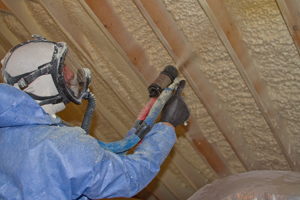In Business Since | License #
In Business Since | License #


Insulating the attic ceiling. Spray foam does an excellent job in insulating cathedral ceilings and attic ceilings.
Even though insulation plays a critical role in keeping a house comfortable and affordable to heat and cool, many houses aren’t adequately or correctly insulated. Today, with energy costs and extreme weather on the rise, it’s more important than ever for houses to be well insulated. Ceiling insulation is an important component in any home’s weatherization plan.
Dr. Energy Saver specializes in all kinds of insulation, including ceiling insulation. When one of our dealer inspects your home, we'll discover exactly what spaces need these services. Call or click below to contact your local Dr. Energy Saver today!
Basement ceiling insulation can only insulate the floor directly above the basement. It does nothing to make the basement more comfortable. Home energy experts recommend that basement walls be insulated (usually with rigid foam insulation) to bring the basement inside the home’s building envelope. Insulating the basement walls benefits your above-grade living space as well as the basement.
Ceiling Insulation above the living space is the same as attic floor insulation. Fiberglass batts, blown-in cellulose and blown-in fiberglass insulation are most commonly installed in the attic. Most houses have inadequate levels of attic insulation according to current Dept. of Energy recommendations. Fortunately, Dr. this deficiency can be corrected affordably in most cases.
Cathedral Ceiling Insulation When the ceiling in a living space is sloped rather than flat, it’s usually referred to as a cathedral ceiling. The insulation space in a cathedral ceiling is limited because of the width of the rafters. Usually this type of ceiling has insulation baffles installed between rafters to maintain roof ventilation. The baffles are secured to the underside of the roof sheathing, and fiberglass batt insulation is fit between rafters and over the insulation baffles. Alternatively, the spaces between rafters in a cathedral ceiling can be filled with spray polyurethane foam (SPF), the most popular type of spray foam insulation. SPF provides higher R-value while also eliminating energy-wasting air leaks.
Dr. Energy Saver will evaluate the ceiling insulation levels in your house as part of our Free Insulation Estimate.
Looking for a price? Get a no cost, no obligation free estimate.